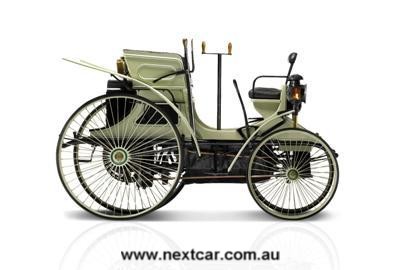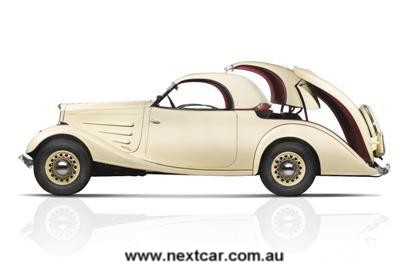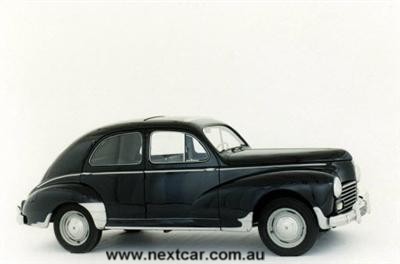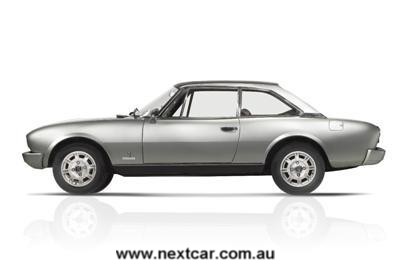Peugeot's 200 years
|
|
|
 Peugeot Type 5
Peugeot Type 5
 Peugeot 401 Eclipse
Peugeot 401 Eclipse
 Peugeot 203
Peugeot 203
 Peugeot 504 coupe
Peugeot 504 coupe
|
|
|
Home >
News >
Peugeot
27th May, 2010
Peugeot’s 200th anniversary sees the culmination of two
centuries marked by revolution, evolution and innovation.
Two hundred years ago, two Peugeot brothers, Jean-Pierre and Jean-Frédéric, established the Peugeot
company with the making of ‘la société Peugeot-Frères et Jacques Maillard-Salins’. The company was
set-up after the brothers had converted their father’s corn mill into a steel mill to make the most of the
industrial revolution which was gathering pace.
Since then, Peugeot has been associated with saws, tools, steel crinoline stays, salt and pepper mills,
coffee grinders, bicycles, motor cycles, scooters, cars and vans. Each of these diverse products is founded
on those early origins in steel while bearing Peugeot’s hallmark of modernity and innovation.
The Lion
As early as 1858, Peugeot adopted the lion as the universal emblem of its saws and ancillary tools. The
choice of the lion was made to illustrate the strength of the teeth, the suppleness of the blade and the
rapidity of cut. Since then the Marque’s emblem has been represented in a variety of ways, right up to the
brand new 2010 two-tone version.
A rapidly evolving brand
Throughout its 200 years, Peugeot has developed a unique long-term vision, enabling it to anticipate
underlying trends, keep abreast of the times to adapt and accept new challenges. This vision led Peugeot to
successfully produce bicycles and motor cycles from 1886, and then in 1891 the motor car.
From the first petrol-powered four-wheeler codenamed the Type 2, to its more recent products, Peugeot
draws its strength from its industrial roots in the east of France allied to a pioneering spirit. That
spirit led Peugeot to manufacture the 403, the first mass-produced diesel powered saloon; to launch the
205, an icon thanks to its many versions and sporting victories; to introduce the particulate filter as a
world first on the 607; to drive an HDi FAP engine to victory at Le Mans and to develop the BB1, the urban
crossover between the car and the scooter.
By continually nurturing its engineering, human and industrial development, Peugeot has grown from an
annual production rate numbered in dozens to a present day average daily production of several thousand
units across 18 'families' of cars and light commercial vehicles.
Peugeot’s genetic marker; the numbering system
Expansion started after the First World War, as demand for more and more varied cars grew and in 1929
Peugeot instigated the numeric identification system that is still in use today. The 201, named purely
because it was the engineering department’s 201st project, was the first car to carry a number and this
evolved to become the three-digit naming system. The first digit indicates which family the vehicle
belongs and the third number indicates the model’s generation. The second number, the 0, is the link
between them.
Since then, the 2-series and 4-series are the only ranges that have continued this system without
interruption. More than 26 million of these cars have been sold, representing nearly half of the marque’s
total sales.
In 2000, letters were added to the three numbers to designate specific body shapes; CC for Coupé
Cabriolet, SW for the family/leisure body shape. In 2004, 75 years after the 201, Peugeot added a
four-digit monicker to depict models that were not part of the original range, starting with the 1007.
Uniquely ‘Peugeot’ innovations
Independent suspension
Comfort on the road is a regularly acknowledged quality of Peugeot vehicles and, perhaps due to the
hilly countryside around its Franche Comté home, Peugeot has frequently led the way with innovations in
suspension systems. The 201 was the first car to be equipped with independent front wheels, guaranteeing
comfort for its occupants and Peugeot is still the only manufacturer to produce its own shock absorbers
to fit on its models. Today, Peugeot is still committed to excellent road manners as illustrated by the
3008 which, despite its tall architecture, is impressing drivers with its driveability. The Peugeot 3008
Crossover also features grip-control, allowing the deployment of intelligent drive options in five
different modes.
The coupé cabriolet
Among these innovations, the Coupé Cabriolet deserves special mention, with an ingenious system that
allows the rigid roof to retract into the boot. This made its first appearance as early as the 1930s on
the 401 Eclipse but it was the 206 CC that brought this body shape to a wider public at the turn of the
21st Century and, with 700,000 units sold, it has made Peugeot the world leader in CCs.
Diesel engines
Peugeot is also synonymous with the development of the diesel engine, which it made available for the
first time on a production model, the 403, in 1959. This saloon was also the first car to feature an
automatic cooling fan controlled by engine temperature. The popularity of diesel was instant, with the
403 being the first Peugeot model to pass the one million sales mark.
More diesel innovations were to follow: in 1975, the 604 became the first car in Europe to be equipped
with a turbo diesel engine and, in 1999, the 607 was the world’s first car to be equipped with a particle
emissions filter, a technology that has helped cement Peugeot’s position as a world leader in emissions
reductions. More than 2.3 million Peugeots are equipped with the particle emissions filter.
The environment drives further innovation
It was as early as 1941 that Peugeot first pioneered electric power with the VLV, a light urban
vehicle with an electric motor, several hundred of which found their way onto the streets of Paris.
However, concern over the potential of mankind's effect on the climate from the late 20th Century has
driven (so to speak) an explosion in low carbon technologies. Naturally, Peugeot has been at the heart of
this push with the ION concept car in the 1990s, and later the electric 106, which is still the
top-selling zero emissions car.
Of course, the greatest effort has been on making continuous improvements to the efficiency of naturally
aspirated engines and Peugeot is at the forefront of the industry, with half of its cars sold in Europe
emitting less than 130 grammes of CO2/km.
In the northern autumn of 2010, Peugeot will return to the electric car market with the iOn and next year,
Peugeot will combine internal combustion with electric power in the 3008 HYbrid4, a diesel-electric hybrid
producing 35% less CO2 than a diesel engine. This set-up also offers great driving flexibility with optional
four wheel drive.
In 2012, another major step will be taken with the rechargeable plug-in 3008 HYbrid that will produce
just 50 grammes CO2/km.
Environmental performance driven by competitive performance
As long as there have been motor races, there have been Peugeots to take part in them, starting with the
first ever race in 1895, the Paris – Bordeaux – Paris, which was won by a Peugeot.
Success in those early pioneering events drove Peugeot to start developing cars for motor sport, with
equal success, starting with the L76 at Brooklands in 1913. The L76 was powered by the first engine with two
overhead camshafts and four valves per cylinder. It was the precursor to the victorious “Grand Prix”
campaigns which saw Peugeot take the chequered flag at the Indianapolis 500 in 1913, 1916 and 1919.
The 1920s saw successes at the Targa Coppa Florio and Spa 24 Hours before one of the marque’s dealers,
Darl’mat, inspired the development of a competition variant of the 302, the 302 Special Sport. This gained
distinction in the 24 Hours, with three cars crossing the finishing line at the 1937 event, before making its
mark the following year in the 2 litre category.
More recently, the successful African campaigns of the 404 and 504 forged a reputation for reliability
among the marque’s models, establishing a direct link between production cars and their motor sport
derivatives. Of all Peugeots however, it is the 205 that symbolises most strongly the brand’s competitive
spirit, evident not only commercially but also on motor racing circuits the world over. This appetite for
competition led Peugeot to organise a Competition Department, producing racing models that would win in a
variety of demanding competitive events ranging from standard and long-distance rallies to Formula 1 and
Endurance.
Today, endurance and fuel-economy are watch-words for Peugeot alongside performance and so Le Mans has
become a natural focus, with the Peugeot 908 HDi FAP taking the double in 2009. Peugeot is looking to the
future by keeping close watch on a hybrid endurance prototype, the 908 HY.
Style: a key factor of Peugeot's identity
Peugeot has reaffirmed its ambition to be a reference in terms of style with its latest concept, the
SR1, an elegant roadster with ideal proportions. Whilst adopting the most modern styling ideas, SR1
carries the same Peugeot 'genes' shared by stand-out models from the past, such as the 402, the 404, the
504, the 205 and the 406 Coupé .
|
|
|

Self-Catering Holiday
Accommodation in
Denmark, WA
..... more
|
|
|
These genes were first set down in the 1930s with Peugeot’s first styling department, headed up by Henri
Thomas. After the classic good looks of the 201, the new Director of Style gave the 2 series an aerodynamic
style, whilst the 402, presented at the 1935 Paris Motor Show, appealed with its inclined front grille
depicting a coat of arms and its streamlined guards.
Perhaps the most instant characteristic of all modern Peugeot cars is the slanted, feline headlamps, an
initiative first put into production on the 504 under Stylistic Director, Paul Bouvot. This visual signature
is an essential feature of the Peugeot style, as is the dynamism that Gérard Welter gave to each of the
models designed while he was in charge, including the 205, marketed with the slogan; “a manufacturer draws
its claws”.
Peugeot has also held a number of styling collaborations, starting in the 1930s with the superb 302
roadsters and coupés and later, Peugeot drew inspiration from the Turin based coachbuilder Pininfarina for
the 403 in 1955. This collaboration proved particularly prolific and gave rise to several of the marque’s
finest designs: the 504 Coupé, 306 Cabriolet and 406 Coupé.
Looking forward, the BB1 and SR1, initiatives of Jean-Pierre Ploué and Gilles Vidal, convey strong
messages for the future. The BB1 4-seater zero emissions micro-car concept opens up new avenues in urban
mobility whilst the SR1 for its part lifts the veil on large Peugeots of tomorrow.
Pedal-powered Peugeots; from the Grand Bi to the electrically powered bicycle
Well before the start of the motor car story, the bicycle’s history began in 1886 in spectacular fashion
with the Peugeot Grand Bi with its 1.35 metre diameter wheel. This exotic invention quickly made way for
bicycles with wheels of equal diameter and in 1890, Peugeot presented the hugely popular Lion which was
characterised by its lightness (22 kg) compared to other cycles of the time.
First entered in the 1905 Tour de France, Peugeot Cycles have numerous victories to their name and have
become renowned for quality gear changes and transmissions, as well as a comprehensive range that places
the firm at the forefront of bicycle manufacturers. The bicycle boom quickly became established and sales
of Peugeot cycles rose to 50,000 units in the 1950s, culminating at more than 400,000 in the 1970s.
Today, Peugeot is investing again in the bicycle with a range that provides an original and practical
response to the challenge of mobility. With the introduction of an electrically powered bicycle this year,
Peugeot is the only manufacturer to propose an integral electric mobility solution, with the iOn electric
city car and the e-Vivacity electric motor scooter.
Peugeot petrol power on two-wheels
Peugeot first added petrol power to its bicycles in 1898 at the Beaulieu plant, the marque’s historic
'birthplace' for bicycles, cars and motorcycles. As early as 1904 Peugeot motor cycles grabbed the
headlines by setting the world speed record, followed by a string of victories, including the 1924
Nations Grand Prix, the 9 world records of the 515 in 1934, and success at the 1952 Bol d’Or.
In the 1960s, the trend moved from motor cycles to mopeds with breathtaking success. In 1973 alone
Peugeot broke the records by selling over 550,000 of its famous “100” family. The 1980s saw the advent
of the scooter and Peugeot was the first to launch the new-generation scooter with a plastic body in
1982 and this soon became the preferred mode of urban transport. During the 1990s, Peugeot enjoyed
further success, in particular with the SV, and became the first manufacturer to sell the electric
scooter with the Scoot’Elec in 1996.
The 21st century saw further Peugeot innovation as it introduced the first ABS braking system as
standard on a 125 cc scooter. In 2004, the Ludix 50 modular scooter immediately became a best seller in
Europe in its category. One year later, Peugeot was the first manufacturer to develop a 125 cc engine
turbocharged by a volumetric compressor, brought to market on the Satelis range which took Peugeot into
the top-of-the-range GT scooter market.
This year, more than 110 years after the appearance of the first Peugeot motor cycle, the marque is
still present making it the oldest manufacturer of motorised two-wheel vehicles in the world.
In 2010, Peugeot evolves again
At the beginning of 2010 Peugeot reinvented itself, presenting a new plan and making clear its
ambitions for 2015: to climb three places in the world ranking of car manufacturers; to make Peugeot
the benchmark in terms of style and to become the leader in mobility services.
To reach these objectives, Peugeot can rely on an ambitious product strategy with no fewer than 14
new models scheduled to appear between 2010 and 2012, new style lines illustrated to perfection by
the SR1 concept car, new mobility offers and also a new visual identity with a more modern, two-tone
Lion and a new international signature: Peugeot, MOTION & EMOTION.
A global manufacturer with 55 million vehicles to its name, unique in its ability to propose an
offer of global mobility, Peugeot has the strengths to face the future with confidence and rise to
the challenge of providing ever greater harmony between the motor car and its environment.
Note to Editors:
Facts and Figures
Key vehicle production figures and dates
Peugeot today
- The leading French vehicle manufacturer in the world in terms of global registrations in 2009
- The 10th ranked vehicle manufacturer worldwide in 2009
- 50% of Peugeots sold worldwide in 2009 had emissions of less than 140 g/km CO2.
- International Engine of the Year 2009 Award (1.6 litre THP engine) for the third year running
- A commercial presence in 160 countries
- 10,000 points of contact with customers
200 years of history at the Peugeot Museum
The Museum of l’Aventure Peugeot in Sochaux (France) opened its doors in 1988 and shows public
collections of small metalwork objects, two-wheelers and cars. The collection includes 450 cars, 350
motor cycles and bicycles, more than 3,000 assorted objects, as well as a documentary and iconographic
treasure trove containing more than two million items. The Museum presents each vehicle in context
with its period, providing an accurate record of Peugeot’s development over time.
In 2010, the Museum opened up two new spaces, increasing the exhibition floor space to 6,000 m2.
These new areas showcase new collections, including the 5 series, light commercial vehicles and a
special focus on Peugeot’s achievements in motor sport.
|